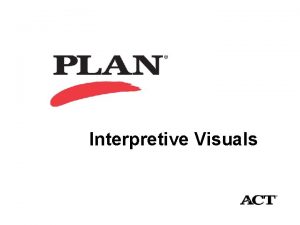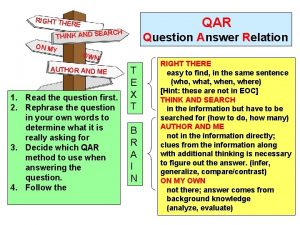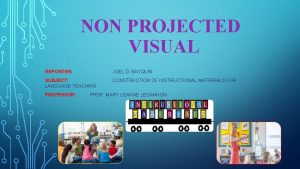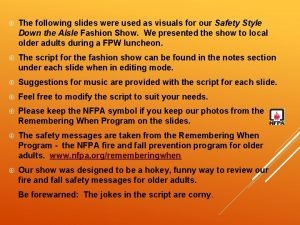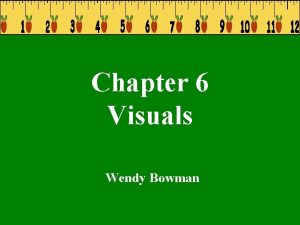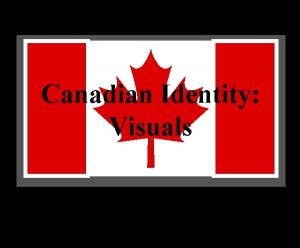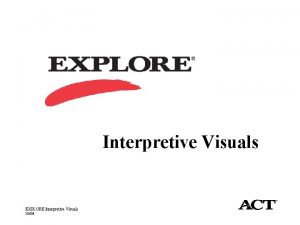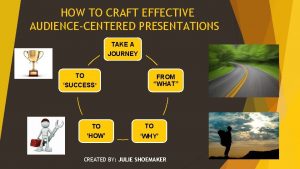Chapter 7 Using AudienceCentered Visuals Strategies for Technical















- Slides: 15

Chapter 7 Using Audience-Centered Visuals Strategies for Technical Communication in the Workplace Laura J. Gurak John M. Lannon 1 © 2010 Pearson Education, Inc. , publishing as Longman Publishers.

Why Visuals Matter Visuals convey information quickly and efficiently, and they help readers understand § § § Which information is most important What numbers mean, how processes work, or how something is organized What something looks like 2 © 2010 Pearson Education, Inc. , publishing as Longman Publishers.

When to Use Visuals Use visuals whenever § they make your point clearer § they enhance the text 3 © 2010 Pearson Education, Inc. , publishing as Longman Publishers.

How Visuals Work Visuals work to: § § § Enhance comprehension by displaying abstract concepts in concrete, geometric shapes Make meaningful comparisons possible Depict relationships Serve as a universal language Provide emphasis Focus and organize information, making it easier to remember 4 © 2010 Pearson Education, Inc. , publishing as Longman Publishers.

What Types of Visuals to Consider Tables display organized lists of data Graphs display numerical relationships Charts depict relationships Graphic illustrations rely on pictures 5 © 2010 Pearson Education, Inc. , publishing as Longman Publishers.

How to Select Visuals n n n What is my purpose? Who is my audience? What form of information will achieve my purpose for this audience? 6 © 2010 Pearson Education, Inc. , publishing as Longman Publishers.

Tables Ø Ø Ø Tables are used to display dense textual information such as specifications, comparisons or conditions. No table should be overly complex for the intended audience. Tables work well for displaying exact values. Death Rates for Heart Disease Year Male Female 1980 369 305 1990 298 282 2000 256 260 7 © 2010 Pearson Education, Inc. , publishing as Longman Publishers.

Graphs translate numbers into shapes that are easy to interpret and compare. Types of graphs include: § Simple bar graphs § Multiple-bar graphs § Horizontal bar graphs § Stacked bar graphs § 100 -percent bar graph § Deviation bar graph § 3 -D bar graph 8 © 2010 Pearson Education, Inc. , publishing as Longman Publishers.

Line Graphs Line graphs can accommodate many more data points than a bar graph. Total Sales § Simple line Graph Multiline Graph § Deviation line Graph § Band or area Graph § Price Types of graphs include: Volume 9 © 2010 Pearson Education, Inc. , publishing as Longman Publishers.

Charts § § § Pie charts Organization charts Flowcharts Tree charts Gantt and PERT charts Pictograms 10 © 2010 Pearson Education, Inc. , publishing as Longman Publishers.

Example of a Pictogram Sales of Pharmaceuticals by Division $8, 000 $6, 000 $4, 000 $2, 000 Midwest West South Northeast 11 © 2010 Pearson Education, Inc. , publishing as Longman Publishers.

Graphic Illustrations n n n Diagrams § Exploded § Cutaway § Block Maps Photographs 12 © 2010 Pearson Education, Inc. , publishing as Longman Publishers.

Ethical Considerations § § Avoid visual distortion. Present the real picture. Present the complete picture. Don’t mistake distortion for emphasis. An example of distortion is on the next slide. 13 © 2010 Pearson Education, Inc. , publishing as Longman Publishers.

Example of Visual Distortion Avoid this graphic Use this graphic Sales of Beer by Store 14 © 2010 Pearson Education, Inc. , publishing as Longman Publishers.

Any Questions? For additional help reviewing this chapter, please visit the Companion Website for your text at http: //www. pearsonhighered. com/gurak. 15 © 2010 Pearson Education, Inc. , publishing as Longman Publishers.
 Interpretive visuals
Interpretive visuals Toilet training visual aids
Toilet training visual aids Alachua visuals llc
Alachua visuals llc Interpretive visuals
Interpretive visuals Qar visuals
Qar visuals Non projected visuals
Non projected visuals Qar visuals
Qar visuals Power bi custom visuals development
Power bi custom visuals development Power bi custom visuals programming language
Power bi custom visuals programming language Use developer tools to create custom visuals power bi
Use developer tools to create custom visuals power bi As visuals
As visuals Tailing a hedge
Tailing a hedge Strategies for technical communication pearson
Strategies for technical communication pearson Hedging strategies using futures
Hedging strategies using futures Imperfect hedge
Imperfect hedge Tailing the hedge
Tailing the hedge



